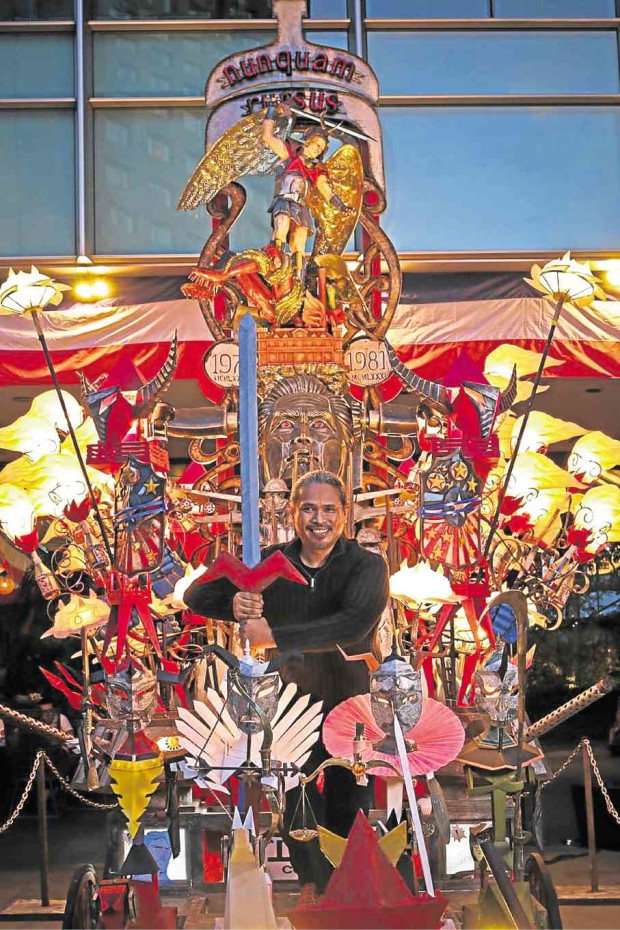Artist Abdulmari Imao Jr. remembers the exact moment martial law invaded his life.
It came through the family living room.
It was 6 p.m. on a Friday in 1979. The 11-year-old boy nicknamed Toym was at his usual comfy spot in front of the TV, waiting for the popular Japanese anime, “Voltes V.”
But the catchy opening theme of the cartoon series didn’t play. Instead of the latest exploits of the iconic robot, an unfamiliar kiddie show went on air. The Marcos dictatorship, through its media watchdog, had pulled the plug on “Voltes V” supposedly to due to its “excessive violence.”
The censors’ move soured the childhood of Imao’s generation, who missed the last four episodes. Curiously, those episodes were leading to the final battle between Earth’s defenders and the despot-ruled Boazanian empire—a scenario whose parallels with the day’s political realities were not hard to miss.
“At a young age, I couldn’t really understand what the protesters were fighting against,” Imao told the Inquirer. “And when they yanked the show off the air, I realized life was imitating art and art was imitating life.”
Imao, now an accomplished artist at 48, recounted the experience as he added his voice to anti-Marcos sentiments enflamed by the surprise burial of the late dictator at Libingan ng mga Bayani on Friday.
For Imao, burying Marcos at the “heroes’ cemetery” was a personal insult: His father, the late National Artist Abdulmari Asia Imao, now has to share the same hallowed ground with the tyrant.
‘Despicable’
“When I heard the news, I had so much rage that I felt like crying,” Imao said. “We’ve been expecting it but it had been done in such a despicable and sly manner, something that obviously cannot be done without the administration’s blessing.”
National Artist Alejandro Roces, one of Toym’s beloved mentors, also rests at Libingan.
Imao said his own family had also been torn apart by martial law. In their native Sulu province, he said, the dictatorship sowed the seeds of insurgency and conflict that rages to this day, long after Marcos’ death in 1989.
As an artist, Imao knows that the best way to air his dissent is to make more art that will awaken and empower the people.
“I decided to do alternative images of history in alternative places,” he said. Many of his installations are in public spaces, like the University of the Philippines-Diliman campus and the Bantayog ng mga Bayani, both in Quezon City.
His works often draw imagery from popular art to draw viewers closer.
One of his first public installations found a metaphor in his disrupted Voltes V experience. The work titled “Last, Lost, Lust in the Four Forgotten Episodes” depicted Marcos as the Boazanian mothership—a giant, horned skull.
Biggest fear
His “Desaparecidos” installation features human figures bearing empty picture frames that have also opened gaping holes in their lives. They symbolize the families of students, activists, community and labor organizers, and political leaders who dared to question Marcos and were never again seen.
The artist said his biggest fear today is seeing the Marcoses regaining political power—and making another generation of Filipinos suffer.
“This is me sounding the alarm and using narratives that span across generations,” he said. “It is so hard to change the world, so let’s just work on changing our youth.”
After the Supreme Court approved a Libingan interment for Marcos on Nov. 8, Imao started wearing a small brass pin depicting the Laser Sword—Voltes V’s ultimate weapon.
“I will not take off this sword until Marcos’ body is moved out of Libingan and buried where he belongs,” he said. “This is the symbol of my generation’s defiance.”
“I am all the more driven to create more and be a storyteller,” he said, stressing how artists tend to thrive in adversity. “And if this (Marcos burial at Libingan) will be written about in the future, let it be known that the people rose against it, not just through protest actions but also through art.”
